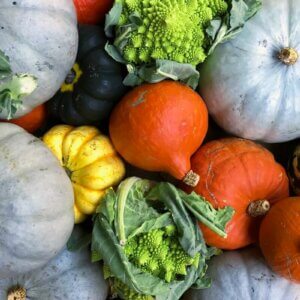“What is that?” I asked, pointing to the spikey, green gourd-like side dish on my plate.
“Bitter melon,” my friend answered simply. We were sharing dinner at her place for a change, enjoying foods from the garden and the local market. “It doesn’t grow locally, but I found it at the small Chinese market downtown. Thought I’d try it.”
“Where does it grow?”
“In Asia, Africa and the Caribbean, from what my research says.” She gave me a nudge. “Try it. You’ll be surprised.”
“Is it really bitter?”
“Can be if eaten raw, but it cooks up nicely and goes well with the stir fry I made with pork and garden veggies.” I watched my friend dig into her bitter melon and mix it on the fork with some stir fry. She didn’t grimace as she chewed and swallowed, so I figured it couldn’t be that bad. I took a deep breath and dug in.
Bitter melon (Momordica charantia or M. charantia) is also known as goya, bitter apple, bitter gourd, bitter squash, balsam-pear (and many other names). It comes by its ‘bitter’ name naturally.
DESCRIPTION:
I have to admit, I think the appearance of the bitter melon is more like a squash gourd than a melon. Granted, both melons and squash gourds grow on herbaceous, tendril-bearing vines, but, like the squash gourd, the bitter melon fruit had a warty exterior over its oblong shape.

Like both melons and squash gourds, the plant bears yellow male and female flowers that, once pollinated, mature into fruit. The bitter melon, when cut open in cross-section, it’s mostly hollow with a layer of seedy flesh surrounding the cavity. Also, the seeds are flat. All these particulars are similar to melons and squash gourds.
VARIETIES:
Bitter melon varies in size and shape depending on where it grows. In China, the fruit is 8 to 12 inches long. Its oblong shape tapers at the end. The pale green color is marked with a slightly warty surface. In India, the fruit is narrower with pointed ends, and the warts are more sharp and jagged like teeth. The Indian bitter melon varies from green to white in color.
Bitter melons growing in regions between China and India have their own unique distinctions. Some plants only bearing miniature fruit, about 2 to 3 inches in length. These miniature fruits are popular in various regions of South Asia, including Bangladesh, Pakistan, and Nepal.
NATURAL HABITAT:
Bitter melon is a tropical and subtropical vine that grows well in Asia, Africa, and the Caribbean.
GROWING CONDITIONS:
Bitter melons grow best in tropical and subtropical heat and humidity. It doesn’t like the frost or cold temperatures. Quite the opposite. They love the heat, preferable between 75 and 80°F. The best time to plant is late spring or early summer and plant in a bright, sunny area that receives at least 6 hours of direct sunlight.

They can tolerate some shade, but grow better in full sun. The plant needs well-drained soil enriched with compost or manure. This is a trailing plant and required a trellis, or something sturdy for the vine to grow along and produce its fruit.
Plant bitter melon seeds about ¾ inch deep and space the plants about 20 inches apart. Once there are at least 6 leaves on the new plant, add more fertilizer and repeat every couple of weeks. Each plant produces 2 to 3 melons and the overall lifespan of the plant is about 3 to 4 months. In order to produce larger fruit, remove the extra fruit and keep only one on the vine.
PESTS AND DISEASES:
Bitter melon is infested by the bactrocera tau, a fly, also known as the pumpkin fruit fly. It’s very invasive and destructive.
Diseases that affect this plant include downy mildew, powdery mildew, fusarium wilt, target leaf spot and nematode induced root-knot
CULINARY USES:
Being an edible fruit, bitter melon is best eaten when it’s still green or just beginning to turn yellow. This is when the flesh of the fruit is crunchy with a watery texture, like cucumbers. However, the fruit has a consistent bitter taste, no matter the stage, hence the name. Even the skin is edible, as it’s quite tender.
Like most squashes and gourds, the seeds are best removed before cooking. Bitter raw, when the fruit is soaked in cold water, then drained, some of the strong flavors disappear.
The rind (flesh) of some varieties can become somewhat tougher and more bitter with age. Most varieties, however, don’t change in quality. It is best to harvest the Chinese variety while it’s still a light green to slightly yellow in color, then the pith is a little sweet and can be eaten uncooked in salads.
Fully ripe fruit is usually orange and soft and easy to split into segments. When it’s fully ripe, the seeds are easily visible, covered in a bright red pulp. The young shoots and leaves may also be consumed, uncooked in salads. Cooked, the Chinese use bitter melon in stir-fries, soups, dim sum, herbal teas, and various Chinese cuisine.
It is believed the African variety is the original bitter melon, a dry-season staple food for hunters.
The Indian variety is often served with yogurt to tone down the bitterness. It’s also cooked in curry dishes, thoran and theeval (usually with grated or roasted coconut) and pachadi (which is used as a medicinal food for diabetics, as it’s been documented to reduce blood sugar). Sometimes, it is also deep fried with peanuts or other nuts used in Indian cuisine.
Bitter melon is a healthy source of many vitamins and minerals, including vitamins A, C, E, and B6, thiamine (B1), calcium, iron, and magnesium, to name a few. It’s a high energy source of fiber, too. Like other gourds, bitter melon is a very versatile ingredient to a number of dishes. In Japan, bitter melon is even used to a make a soft drink.
In recent years, researchers have learned that bitter melons help control blood sugar levels in people with diabetes. Additionally, bitter melon has also been documented to kill certain cancer cells, including cancers in the stomach, colon, lung and nasopharynx (the area behind the nose at the back of the throat). It is thought to potentially be used to control blood pressure, cholesterol levels, and combat heart disease, but more tests and clinical trials are needed to support this theory.
It’s also a rich source of fiber which can induce weight loss. It has been used successfully to treat ulcers, malaria, pain and inflammation caused by conditions like osteoarthritis, psoriasis, dyslipidemia and hypertension.
However, like anything good, there can be some adverse side effects to eating bitter melon. It can cause considerable gastrointestinal discomfort, including diarrhea. But, then again, so can many other gourds. It is not recommended for pregnant women as it can induce bleeding, contractions and miscarriage. Long term consumption of bitter melon is not advised as it can affect kidney tissues and functions.
In spite of its unusual names, bitter melon is a versatile, easy-to-grow (in the right environments), plant that makes a good food source.










































Leave a Reply